Economic Assignment: Analysis of Housing Price Inflation in Australia
VerifiedAdded on 2020/05/28
|15
|3310
|164
Report
AI Summary
This economic assignment analyzes the Australian housing market, focusing on the rapid increase in house prices, particularly in Sydney and Melbourne, and the debate surrounding overvaluation. The report evaluates arguments and counterarguments regarding housing price inflation, considering factors like per capita GDP growth, price-to-income ratios, and debt-to-income ratios. It examines the role of financial liberalization, low interest rates, and supply-side constraints, including geographic limitations and population growth, in influencing housing prices. The assignment also delves into the impact of foreign buyers and stamp duty on the Melbourne housing market, utilizing supply and demand analysis to illustrate these effects. The study also considers the role of stamp duty charges on foreign buyers and their impact on the housing market, including the shifts in demand and supply curves. The report uses figures and analysis to support its findings and conclusions.
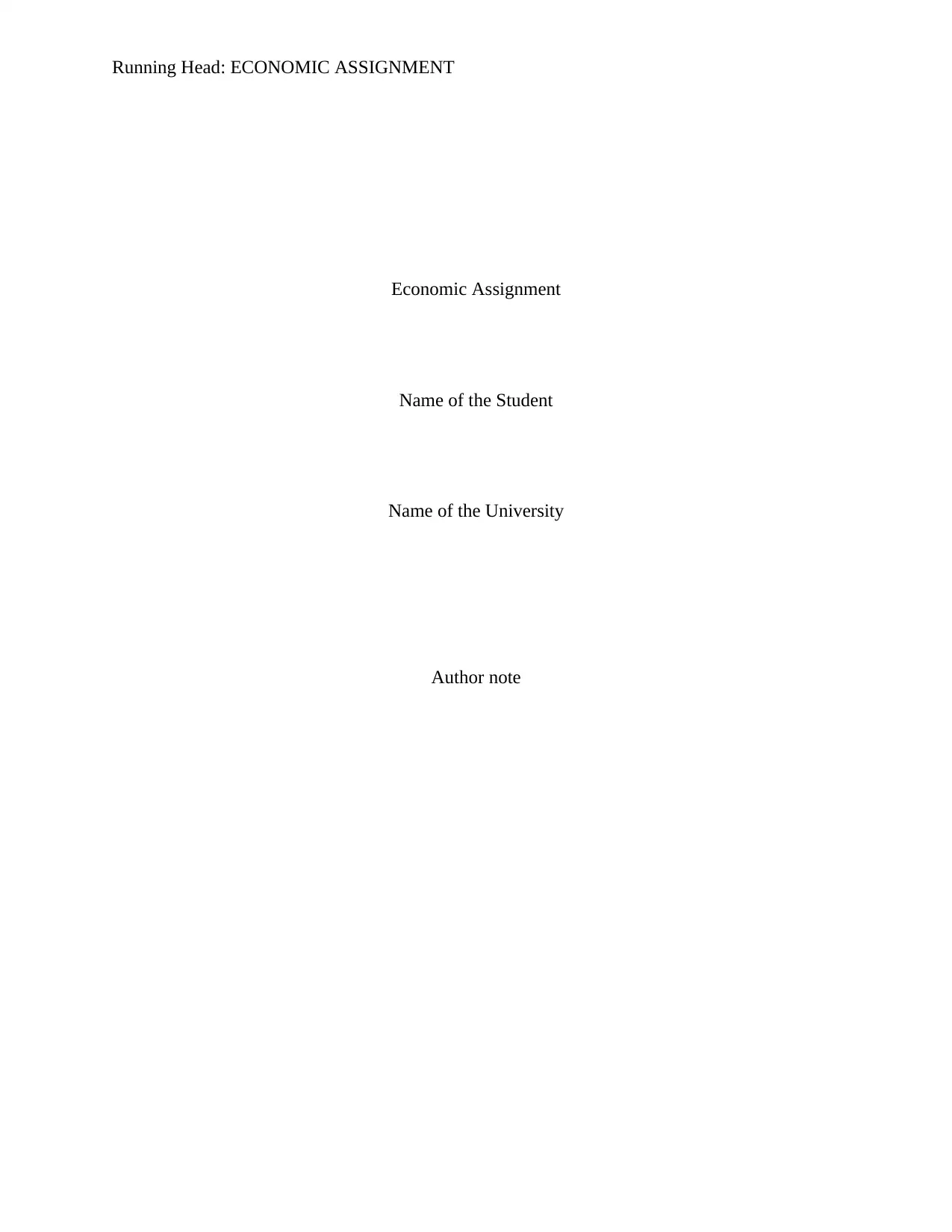
Running Head: ECONOMIC ASSIGNMENT
Economic Assignment
Name of the Student
Name of the University
Author note
Economic Assignment
Name of the Student
Name of the University
Author note
Paraphrase This Document
Need a fresh take? Get an instant paraphrase of this document with our AI Paraphraser
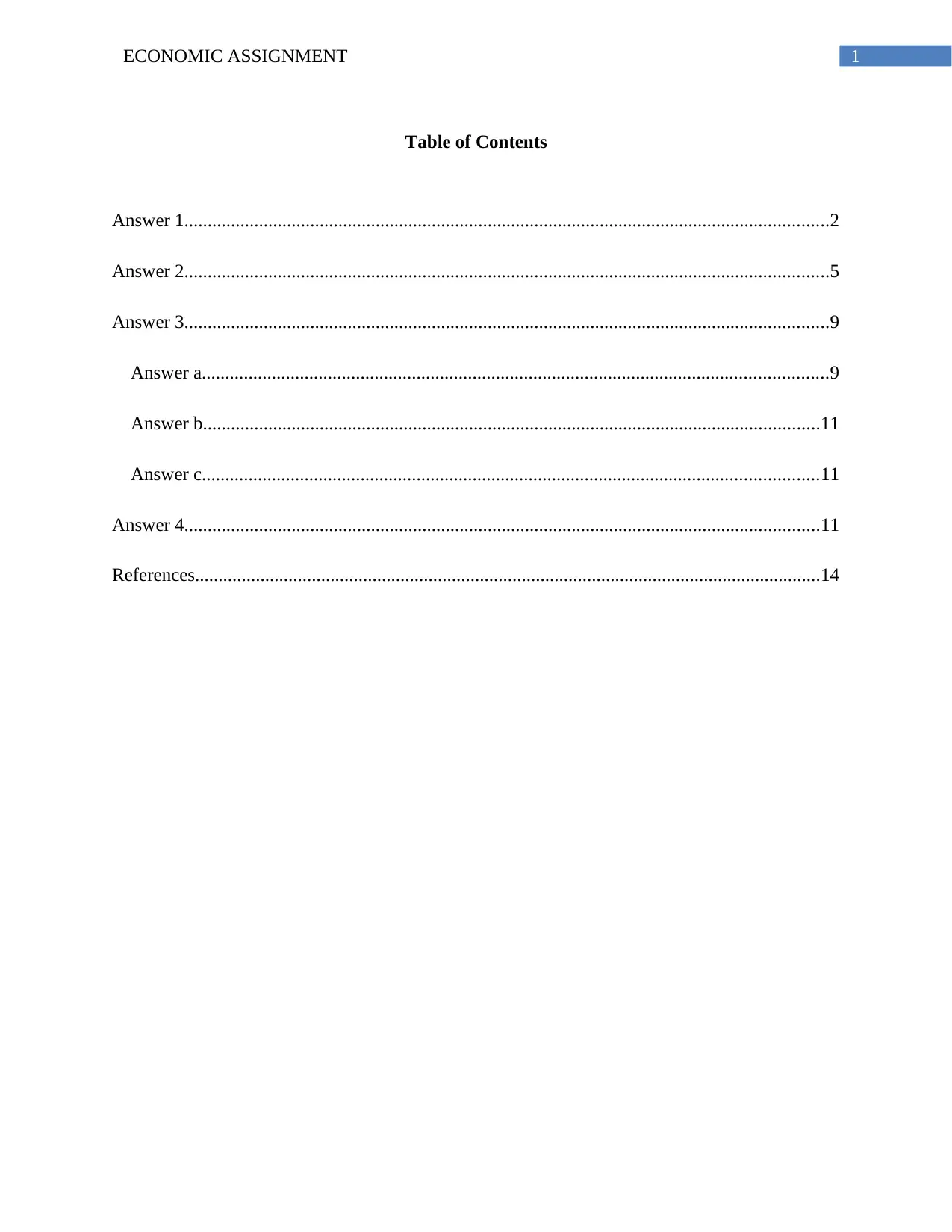
1ECONOMIC ASSIGNMENT
Table of Contents
Answer 1..........................................................................................................................................2
Answer 2..........................................................................................................................................5
Answer 3..........................................................................................................................................9
Answer a......................................................................................................................................9
Answer b....................................................................................................................................11
Answer c....................................................................................................................................11
Answer 4........................................................................................................................................11
References......................................................................................................................................14
Table of Contents
Answer 1..........................................................................................................................................2
Answer 2..........................................................................................................................................5
Answer 3..........................................................................................................................................9
Answer a......................................................................................................................................9
Answer b....................................................................................................................................11
Answer c....................................................................................................................................11
Answer 4........................................................................................................................................11
References......................................................................................................................................14
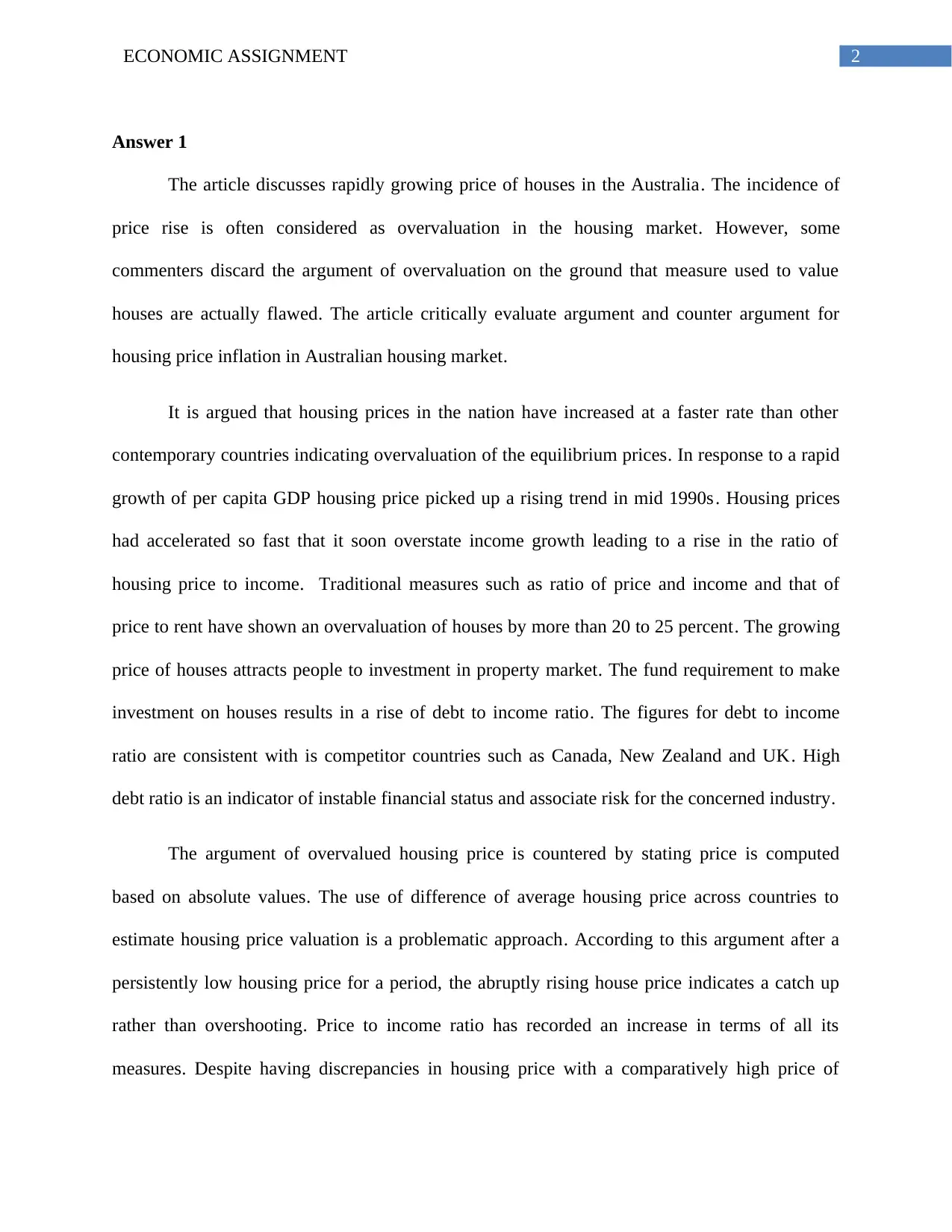
2ECONOMIC ASSIGNMENT
Answer 1
The article discusses rapidly growing price of houses in the Australia. The incidence of
price rise is often considered as overvaluation in the housing market. However, some
commenters discard the argument of overvaluation on the ground that measure used to value
houses are actually flawed. The article critically evaluate argument and counter argument for
housing price inflation in Australian housing market.
It is argued that housing prices in the nation have increased at a faster rate than other
contemporary countries indicating overvaluation of the equilibrium prices. In response to a rapid
growth of per capita GDP housing price picked up a rising trend in mid 1990s. Housing prices
had accelerated so fast that it soon overstate income growth leading to a rise in the ratio of
housing price to income. Traditional measures such as ratio of price and income and that of
price to rent have shown an overvaluation of houses by more than 20 to 25 percent. The growing
price of houses attracts people to investment in property market. The fund requirement to make
investment on houses results in a rise of debt to income ratio. The figures for debt to income
ratio are consistent with is competitor countries such as Canada, New Zealand and UK. High
debt ratio is an indicator of instable financial status and associate risk for the concerned industry.
The argument of overvalued housing price is countered by stating price is computed
based on absolute values. The use of difference of average housing price across countries to
estimate housing price valuation is a problematic approach. According to this argument after a
persistently low housing price for a period, the abruptly rising house price indicates a catch up
rather than overshooting. Price to income ratio has recorded an increase in terms of all its
measures. Despite having discrepancies in housing price with a comparatively high price of
Answer 1
The article discusses rapidly growing price of houses in the Australia. The incidence of
price rise is often considered as overvaluation in the housing market. However, some
commenters discard the argument of overvaluation on the ground that measure used to value
houses are actually flawed. The article critically evaluate argument and counter argument for
housing price inflation in Australian housing market.
It is argued that housing prices in the nation have increased at a faster rate than other
contemporary countries indicating overvaluation of the equilibrium prices. In response to a rapid
growth of per capita GDP housing price picked up a rising trend in mid 1990s. Housing prices
had accelerated so fast that it soon overstate income growth leading to a rise in the ratio of
housing price to income. Traditional measures such as ratio of price and income and that of
price to rent have shown an overvaluation of houses by more than 20 to 25 percent. The growing
price of houses attracts people to investment in property market. The fund requirement to make
investment on houses results in a rise of debt to income ratio. The figures for debt to income
ratio are consistent with is competitor countries such as Canada, New Zealand and UK. High
debt ratio is an indicator of instable financial status and associate risk for the concerned industry.
The argument of overvalued housing price is countered by stating price is computed
based on absolute values. The use of difference of average housing price across countries to
estimate housing price valuation is a problematic approach. According to this argument after a
persistently low housing price for a period, the abruptly rising house price indicates a catch up
rather than overshooting. Price to income ratio has recorded an increase in terms of all its
measures. Despite having discrepancies in housing price with a comparatively high price of
⊘ This is a preview!⊘
Do you want full access?
Subscribe today to unlock all pages.

Trusted by 1+ million students worldwide
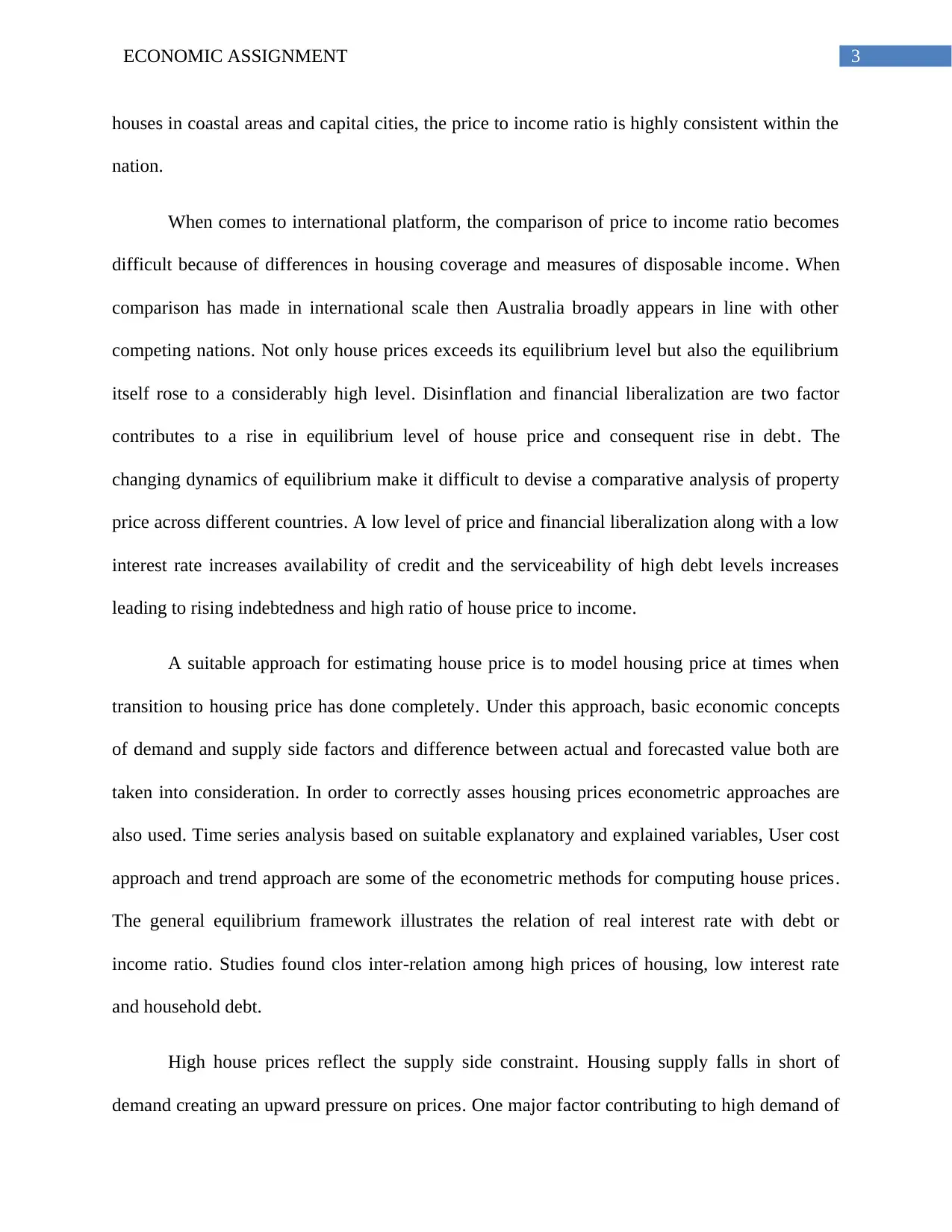
3ECONOMIC ASSIGNMENT
houses in coastal areas and capital cities, the price to income ratio is highly consistent within the
nation.
When comes to international platform, the comparison of price to income ratio becomes
difficult because of differences in housing coverage and measures of disposable income. When
comparison has made in international scale then Australia broadly appears in line with other
competing nations. Not only house prices exceeds its equilibrium level but also the equilibrium
itself rose to a considerably high level. Disinflation and financial liberalization are two factor
contributes to a rise in equilibrium level of house price and consequent rise in debt. The
changing dynamics of equilibrium make it difficult to devise a comparative analysis of property
price across different countries. A low level of price and financial liberalization along with a low
interest rate increases availability of credit and the serviceability of high debt levels increases
leading to rising indebtedness and high ratio of house price to income.
A suitable approach for estimating house price is to model housing price at times when
transition to housing price has done completely. Under this approach, basic economic concepts
of demand and supply side factors and difference between actual and forecasted value both are
taken into consideration. In order to correctly asses housing prices econometric approaches are
also used. Time series analysis based on suitable explanatory and explained variables, User cost
approach and trend approach are some of the econometric methods for computing house prices.
The general equilibrium framework illustrates the relation of real interest rate with debt or
income ratio. Studies found clos inter-relation among high prices of housing, low interest rate
and household debt.
High house prices reflect the supply side constraint. Housing supply falls in short of
demand creating an upward pressure on prices. One major factor contributing to high demand of
houses in coastal areas and capital cities, the price to income ratio is highly consistent within the
nation.
When comes to international platform, the comparison of price to income ratio becomes
difficult because of differences in housing coverage and measures of disposable income. When
comparison has made in international scale then Australia broadly appears in line with other
competing nations. Not only house prices exceeds its equilibrium level but also the equilibrium
itself rose to a considerably high level. Disinflation and financial liberalization are two factor
contributes to a rise in equilibrium level of house price and consequent rise in debt. The
changing dynamics of equilibrium make it difficult to devise a comparative analysis of property
price across different countries. A low level of price and financial liberalization along with a low
interest rate increases availability of credit and the serviceability of high debt levels increases
leading to rising indebtedness and high ratio of house price to income.
A suitable approach for estimating house price is to model housing price at times when
transition to housing price has done completely. Under this approach, basic economic concepts
of demand and supply side factors and difference between actual and forecasted value both are
taken into consideration. In order to correctly asses housing prices econometric approaches are
also used. Time series analysis based on suitable explanatory and explained variables, User cost
approach and trend approach are some of the econometric methods for computing house prices.
The general equilibrium framework illustrates the relation of real interest rate with debt or
income ratio. Studies found clos inter-relation among high prices of housing, low interest rate
and household debt.
High house prices reflect the supply side constraint. Housing supply falls in short of
demand creating an upward pressure on prices. One major factor contributing to high demand of
Paraphrase This Document
Need a fresh take? Get an instant paraphrase of this document with our AI Paraphraser
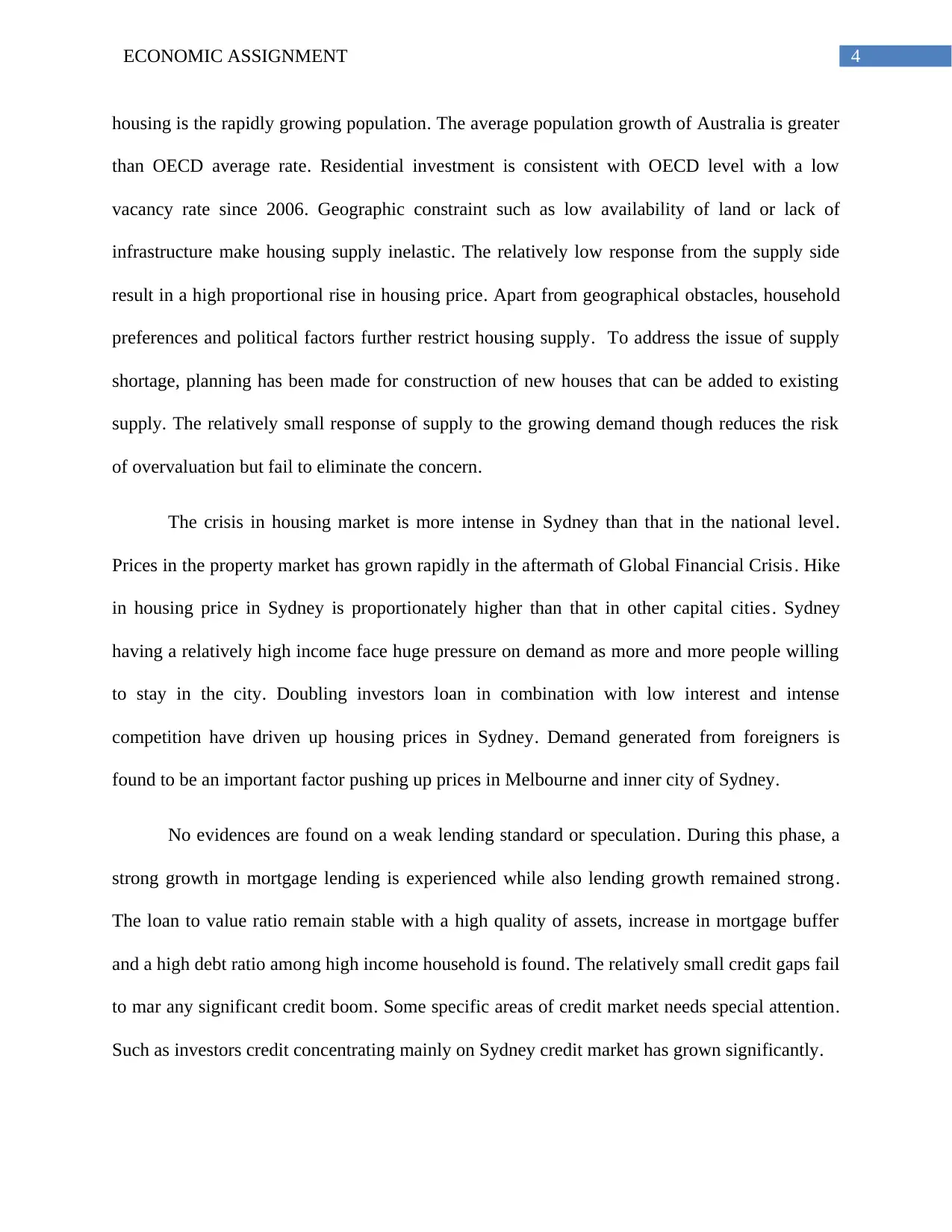
4ECONOMIC ASSIGNMENT
housing is the rapidly growing population. The average population growth of Australia is greater
than OECD average rate. Residential investment is consistent with OECD level with a low
vacancy rate since 2006. Geographic constraint such as low availability of land or lack of
infrastructure make housing supply inelastic. The relatively low response from the supply side
result in a high proportional rise in housing price. Apart from geographical obstacles, household
preferences and political factors further restrict housing supply. To address the issue of supply
shortage, planning has been made for construction of new houses that can be added to existing
supply. The relatively small response of supply to the growing demand though reduces the risk
of overvaluation but fail to eliminate the concern.
The crisis in housing market is more intense in Sydney than that in the national level.
Prices in the property market has grown rapidly in the aftermath of Global Financial Crisis. Hike
in housing price in Sydney is proportionately higher than that in other capital cities. Sydney
having a relatively high income face huge pressure on demand as more and more people willing
to stay in the city. Doubling investors loan in combination with low interest and intense
competition have driven up housing prices in Sydney. Demand generated from foreigners is
found to be an important factor pushing up prices in Melbourne and inner city of Sydney.
No evidences are found on a weak lending standard or speculation. During this phase, a
strong growth in mortgage lending is experienced while also lending growth remained strong.
The loan to value ratio remain stable with a high quality of assets, increase in mortgage buffer
and a high debt ratio among high income household is found. The relatively small credit gaps fail
to mar any significant credit boom. Some specific areas of credit market needs special attention.
Such as investors credit concentrating mainly on Sydney credit market has grown significantly.
housing is the rapidly growing population. The average population growth of Australia is greater
than OECD average rate. Residential investment is consistent with OECD level with a low
vacancy rate since 2006. Geographic constraint such as low availability of land or lack of
infrastructure make housing supply inelastic. The relatively low response from the supply side
result in a high proportional rise in housing price. Apart from geographical obstacles, household
preferences and political factors further restrict housing supply. To address the issue of supply
shortage, planning has been made for construction of new houses that can be added to existing
supply. The relatively small response of supply to the growing demand though reduces the risk
of overvaluation but fail to eliminate the concern.
The crisis in housing market is more intense in Sydney than that in the national level.
Prices in the property market has grown rapidly in the aftermath of Global Financial Crisis. Hike
in housing price in Sydney is proportionately higher than that in other capital cities. Sydney
having a relatively high income face huge pressure on demand as more and more people willing
to stay in the city. Doubling investors loan in combination with low interest and intense
competition have driven up housing prices in Sydney. Demand generated from foreigners is
found to be an important factor pushing up prices in Melbourne and inner city of Sydney.
No evidences are found on a weak lending standard or speculation. During this phase, a
strong growth in mortgage lending is experienced while also lending growth remained strong.
The loan to value ratio remain stable with a high quality of assets, increase in mortgage buffer
and a high debt ratio among high income household is found. The relatively small credit gaps fail
to mar any significant credit boom. Some specific areas of credit market needs special attention.
Such as investors credit concentrating mainly on Sydney credit market has grown significantly.
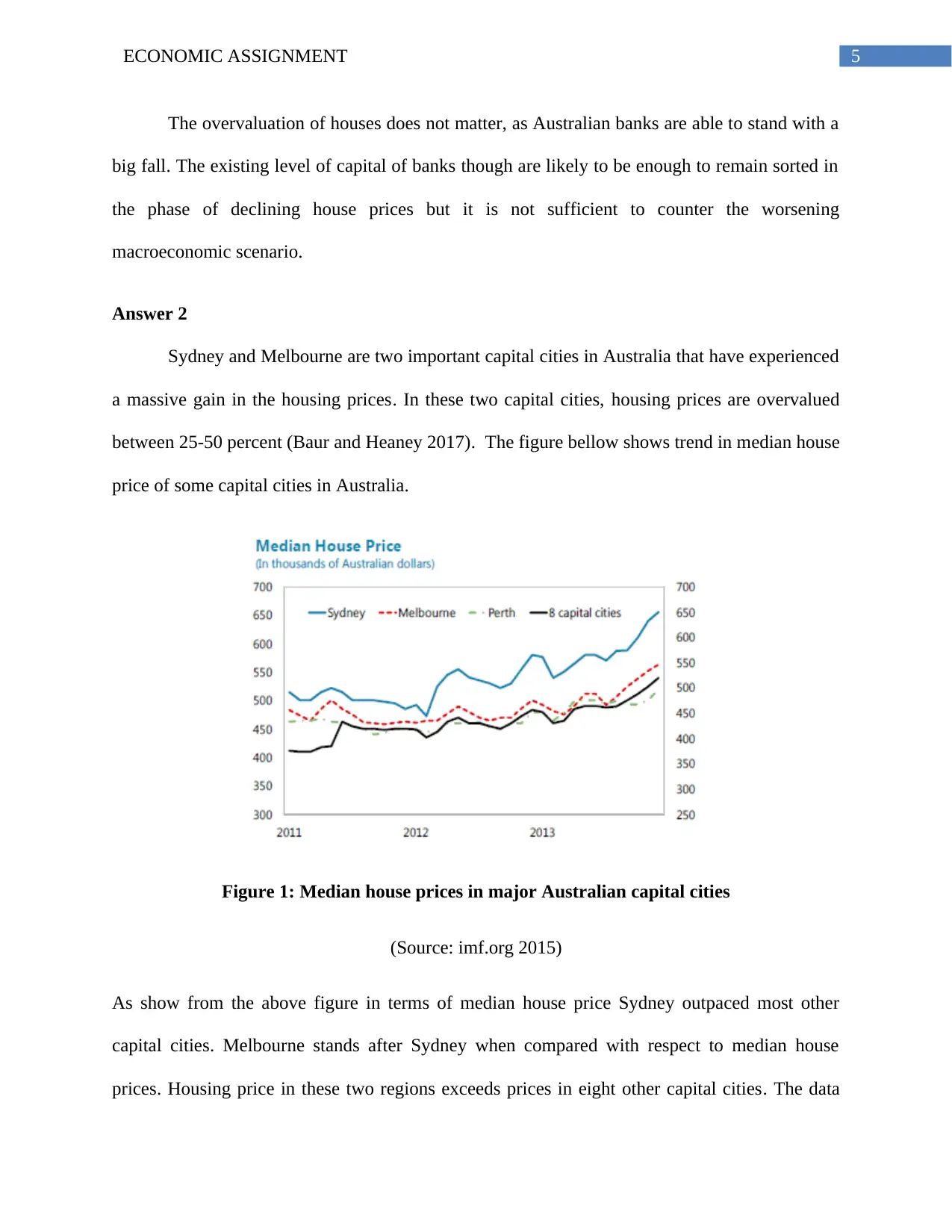
5ECONOMIC ASSIGNMENT
The overvaluation of houses does not matter, as Australian banks are able to stand with a
big fall. The existing level of capital of banks though are likely to be enough to remain sorted in
the phase of declining house prices but it is not sufficient to counter the worsening
macroeconomic scenario.
Answer 2
Sydney and Melbourne are two important capital cities in Australia that have experienced
a massive gain in the housing prices. In these two capital cities, housing prices are overvalued
between 25-50 percent (Baur and Heaney 2017). The figure bellow shows trend in median house
price of some capital cities in Australia.
Figure 1: Median house prices in major Australian capital cities
(Source: imf.org 2015)
As show from the above figure in terms of median house price Sydney outpaced most other
capital cities. Melbourne stands after Sydney when compared with respect to median house
prices. Housing price in these two regions exceeds prices in eight other capital cities. The data
The overvaluation of houses does not matter, as Australian banks are able to stand with a
big fall. The existing level of capital of banks though are likely to be enough to remain sorted in
the phase of declining house prices but it is not sufficient to counter the worsening
macroeconomic scenario.
Answer 2
Sydney and Melbourne are two important capital cities in Australia that have experienced
a massive gain in the housing prices. In these two capital cities, housing prices are overvalued
between 25-50 percent (Baur and Heaney 2017). The figure bellow shows trend in median house
price of some capital cities in Australia.
Figure 1: Median house prices in major Australian capital cities
(Source: imf.org 2015)
As show from the above figure in terms of median house price Sydney outpaced most other
capital cities. Melbourne stands after Sydney when compared with respect to median house
prices. Housing price in these two regions exceeds prices in eight other capital cities. The data
⊘ This is a preview!⊘
Do you want full access?
Subscribe today to unlock all pages.

Trusted by 1+ million students worldwide
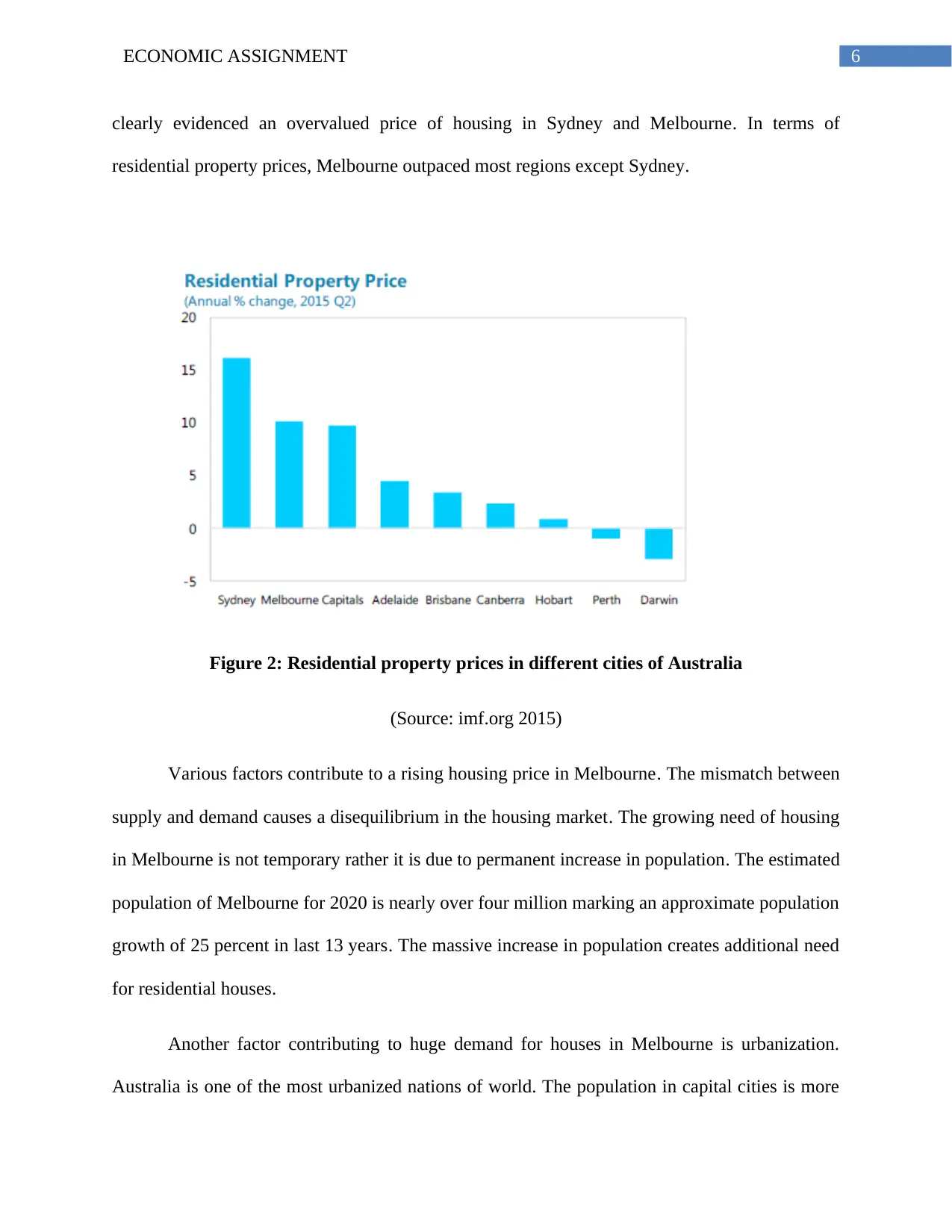
6ECONOMIC ASSIGNMENT
clearly evidenced an overvalued price of housing in Sydney and Melbourne. In terms of
residential property prices, Melbourne outpaced most regions except Sydney.
Figure 2: Residential property prices in different cities of Australia
(Source: imf.org 2015)
Various factors contribute to a rising housing price in Melbourne. The mismatch between
supply and demand causes a disequilibrium in the housing market. The growing need of housing
in Melbourne is not temporary rather it is due to permanent increase in population. The estimated
population of Melbourne for 2020 is nearly over four million marking an approximate population
growth of 25 percent in last 13 years. The massive increase in population creates additional need
for residential houses.
Another factor contributing to huge demand for houses in Melbourne is urbanization.
Australia is one of the most urbanized nations of world. The population in capital cities is more
clearly evidenced an overvalued price of housing in Sydney and Melbourne. In terms of
residential property prices, Melbourne outpaced most regions except Sydney.
Figure 2: Residential property prices in different cities of Australia
(Source: imf.org 2015)
Various factors contribute to a rising housing price in Melbourne. The mismatch between
supply and demand causes a disequilibrium in the housing market. The growing need of housing
in Melbourne is not temporary rather it is due to permanent increase in population. The estimated
population of Melbourne for 2020 is nearly over four million marking an approximate population
growth of 25 percent in last 13 years. The massive increase in population creates additional need
for residential houses.
Another factor contributing to huge demand for houses in Melbourne is urbanization.
Australia is one of the most urbanized nations of world. The population in capital cities is more
Paraphrase This Document
Need a fresh take? Get an instant paraphrase of this document with our AI Paraphraser
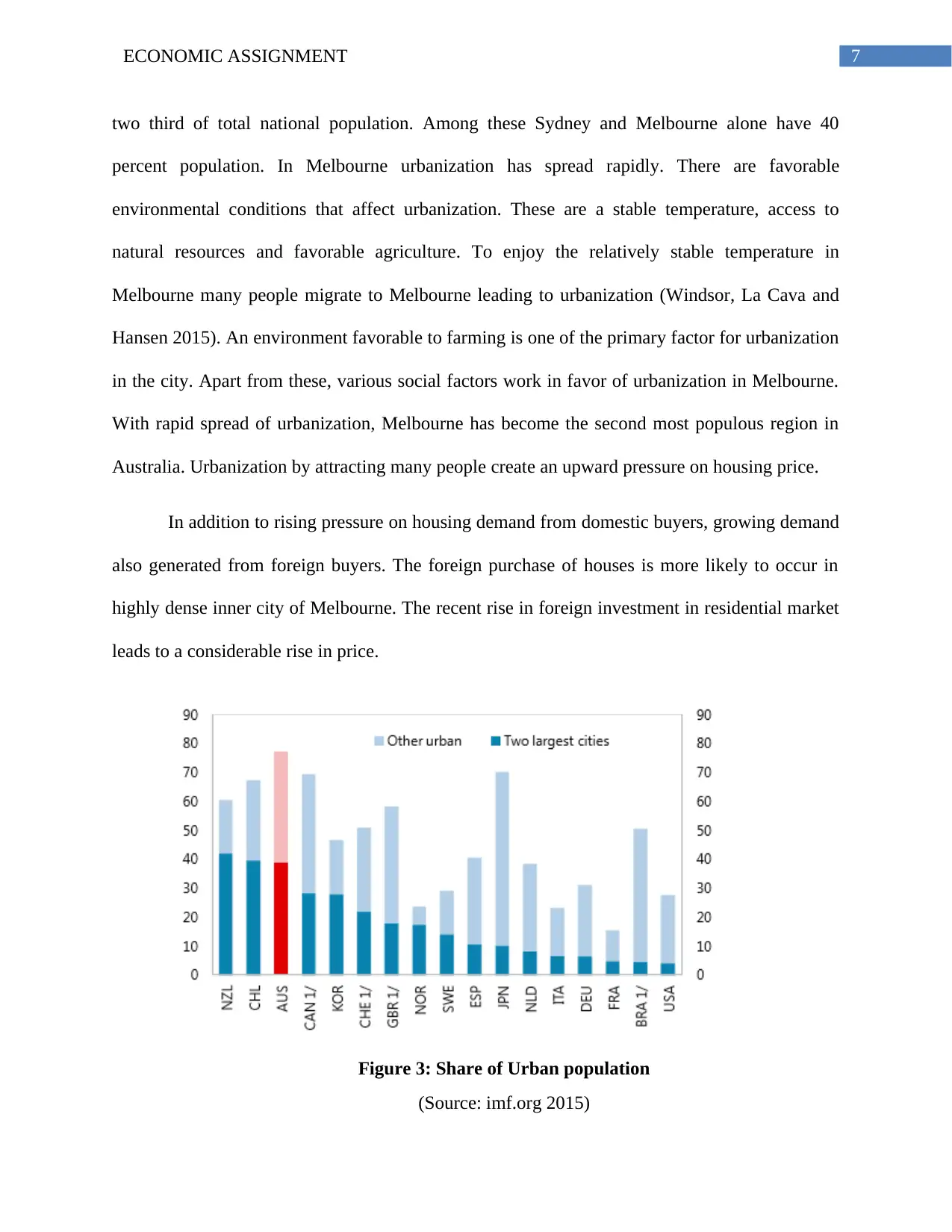
7ECONOMIC ASSIGNMENT
two third of total national population. Among these Sydney and Melbourne alone have 40
percent population. In Melbourne urbanization has spread rapidly. There are favorable
environmental conditions that affect urbanization. These are a stable temperature, access to
natural resources and favorable agriculture. To enjoy the relatively stable temperature in
Melbourne many people migrate to Melbourne leading to urbanization (Windsor, La Cava and
Hansen 2015). An environment favorable to farming is one of the primary factor for urbanization
in the city. Apart from these, various social factors work in favor of urbanization in Melbourne.
With rapid spread of urbanization, Melbourne has become the second most populous region in
Australia. Urbanization by attracting many people create an upward pressure on housing price.
In addition to rising pressure on housing demand from domestic buyers, growing demand
also generated from foreign buyers. The foreign purchase of houses is more likely to occur in
highly dense inner city of Melbourne. The recent rise in foreign investment in residential market
leads to a considerable rise in price.
Figure 3: Share of Urban population
(Source: imf.org 2015)
two third of total national population. Among these Sydney and Melbourne alone have 40
percent population. In Melbourne urbanization has spread rapidly. There are favorable
environmental conditions that affect urbanization. These are a stable temperature, access to
natural resources and favorable agriculture. To enjoy the relatively stable temperature in
Melbourne many people migrate to Melbourne leading to urbanization (Windsor, La Cava and
Hansen 2015). An environment favorable to farming is one of the primary factor for urbanization
in the city. Apart from these, various social factors work in favor of urbanization in Melbourne.
With rapid spread of urbanization, Melbourne has become the second most populous region in
Australia. Urbanization by attracting many people create an upward pressure on housing price.
In addition to rising pressure on housing demand from domestic buyers, growing demand
also generated from foreign buyers. The foreign purchase of houses is more likely to occur in
highly dense inner city of Melbourne. The recent rise in foreign investment in residential market
leads to a considerable rise in price.
Figure 3: Share of Urban population
(Source: imf.org 2015)
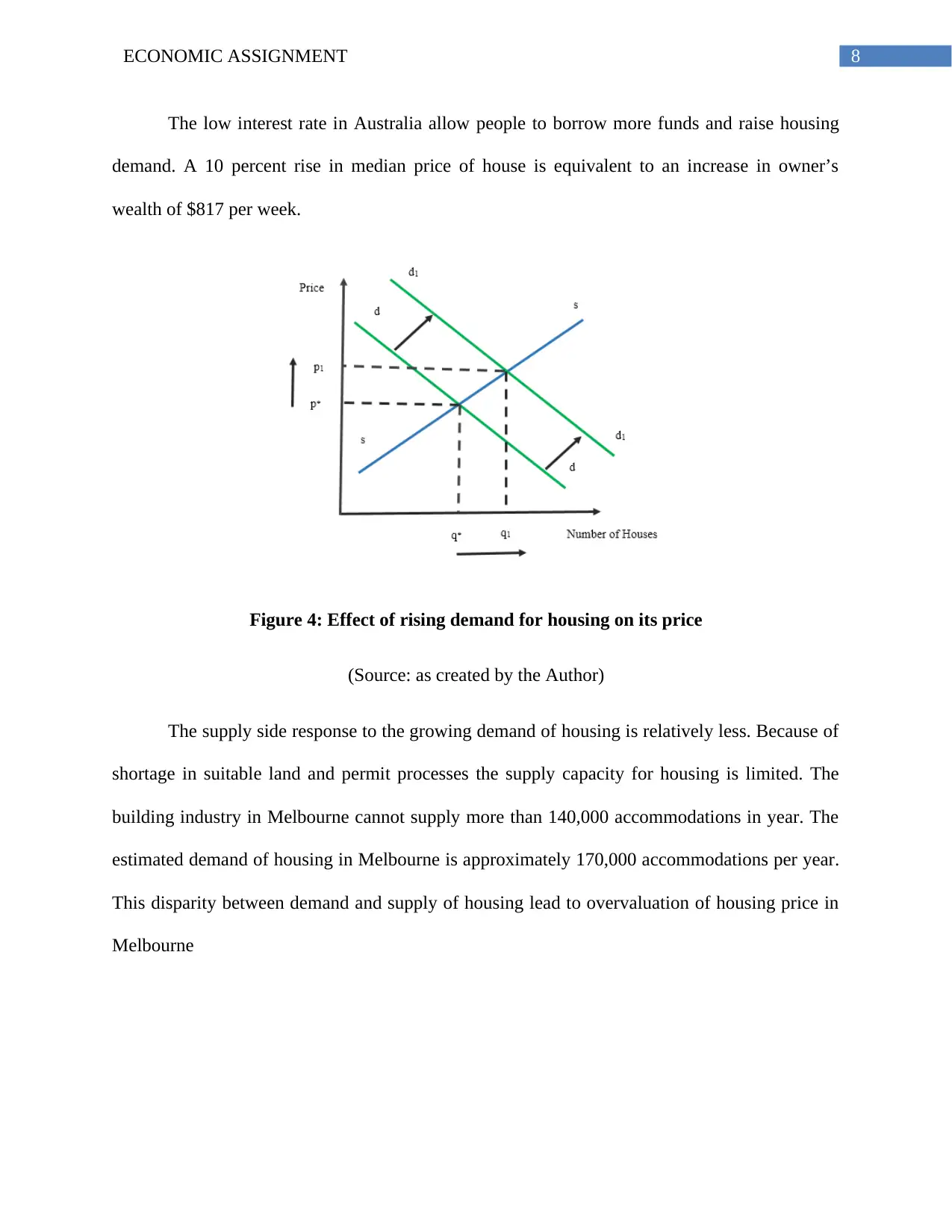
8ECONOMIC ASSIGNMENT
The low interest rate in Australia allow people to borrow more funds and raise housing
demand. A 10 percent rise in median price of house is equivalent to an increase in owner’s
wealth of $817 per week.
Figure 4: Effect of rising demand for housing on its price
(Source: as created by the Author)
The supply side response to the growing demand of housing is relatively less. Because of
shortage in suitable land and permit processes the supply capacity for housing is limited. The
building industry in Melbourne cannot supply more than 140,000 accommodations in year. The
estimated demand of housing in Melbourne is approximately 170,000 accommodations per year.
This disparity between demand and supply of housing lead to overvaluation of housing price in
Melbourne
The low interest rate in Australia allow people to borrow more funds and raise housing
demand. A 10 percent rise in median price of house is equivalent to an increase in owner’s
wealth of $817 per week.
Figure 4: Effect of rising demand for housing on its price
(Source: as created by the Author)
The supply side response to the growing demand of housing is relatively less. Because of
shortage in suitable land and permit processes the supply capacity for housing is limited. The
building industry in Melbourne cannot supply more than 140,000 accommodations in year. The
estimated demand of housing in Melbourne is approximately 170,000 accommodations per year.
This disparity between demand and supply of housing lead to overvaluation of housing price in
Melbourne
⊘ This is a preview!⊘
Do you want full access?
Subscribe today to unlock all pages.

Trusted by 1+ million students worldwide
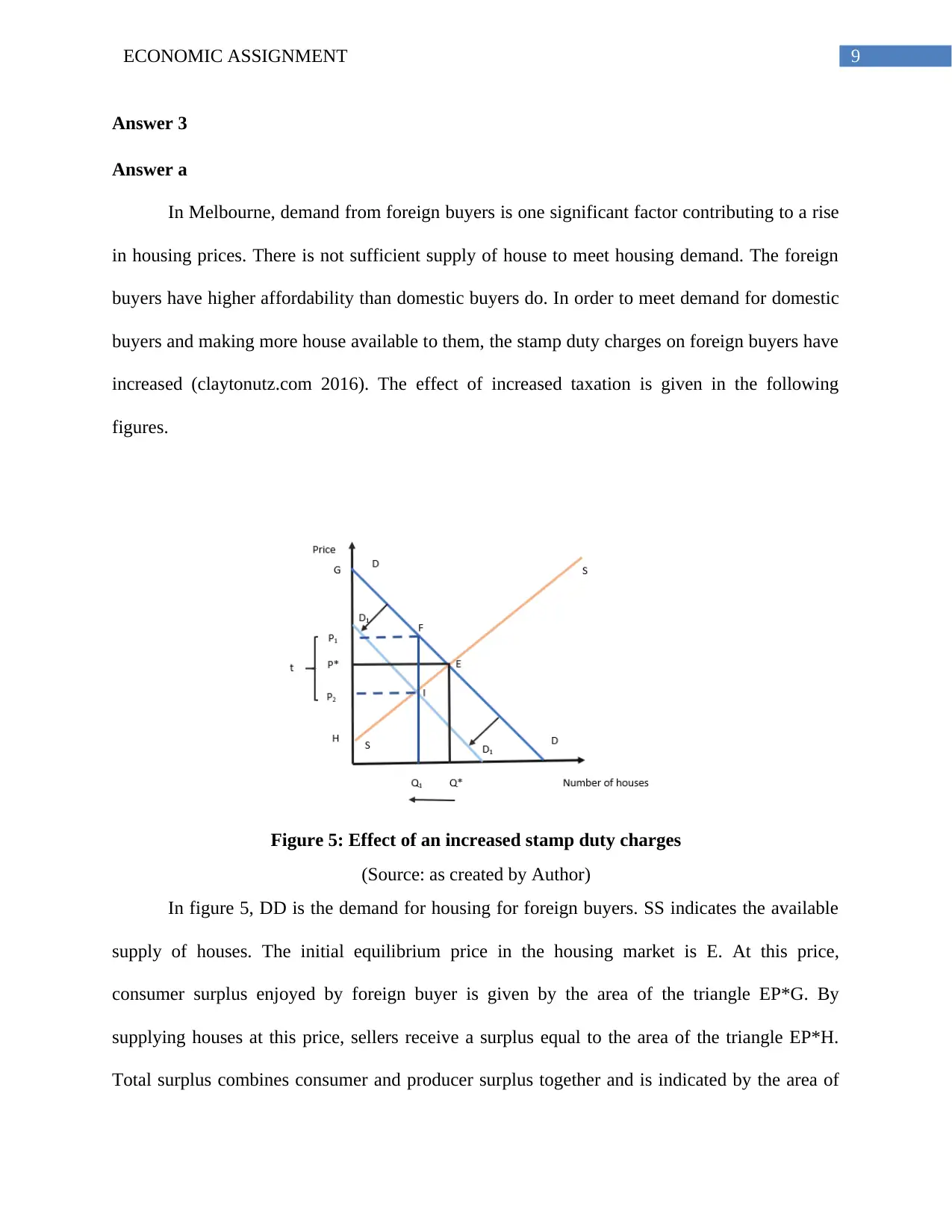
9ECONOMIC ASSIGNMENT
Answer 3
Answer a
In Melbourne, demand from foreign buyers is one significant factor contributing to a rise
in housing prices. There is not sufficient supply of house to meet housing demand. The foreign
buyers have higher affordability than domestic buyers do. In order to meet demand for domestic
buyers and making more house available to them, the stamp duty charges on foreign buyers have
increased (claytonutz.com 2016). The effect of increased taxation is given in the following
figures.
Figure 5: Effect of an increased stamp duty charges
(Source: as created by Author)
In figure 5, DD is the demand for housing for foreign buyers. SS indicates the available
supply of houses. The initial equilibrium price in the housing market is E. At this price,
consumer surplus enjoyed by foreign buyer is given by the area of the triangle EP*G. By
supplying houses at this price, sellers receive a surplus equal to the area of the triangle EP*H.
Total surplus combines consumer and producer surplus together and is indicated by the area of
Answer 3
Answer a
In Melbourne, demand from foreign buyers is one significant factor contributing to a rise
in housing prices. There is not sufficient supply of house to meet housing demand. The foreign
buyers have higher affordability than domestic buyers do. In order to meet demand for domestic
buyers and making more house available to them, the stamp duty charges on foreign buyers have
increased (claytonutz.com 2016). The effect of increased taxation is given in the following
figures.
Figure 5: Effect of an increased stamp duty charges
(Source: as created by Author)
In figure 5, DD is the demand for housing for foreign buyers. SS indicates the available
supply of houses. The initial equilibrium price in the housing market is E. At this price,
consumer surplus enjoyed by foreign buyer is given by the area of the triangle EP*G. By
supplying houses at this price, sellers receive a surplus equal to the area of the triangle EP*H.
Total surplus combines consumer and producer surplus together and is indicated by the area of
Paraphrase This Document
Need a fresh take? Get an instant paraphrase of this document with our AI Paraphraser
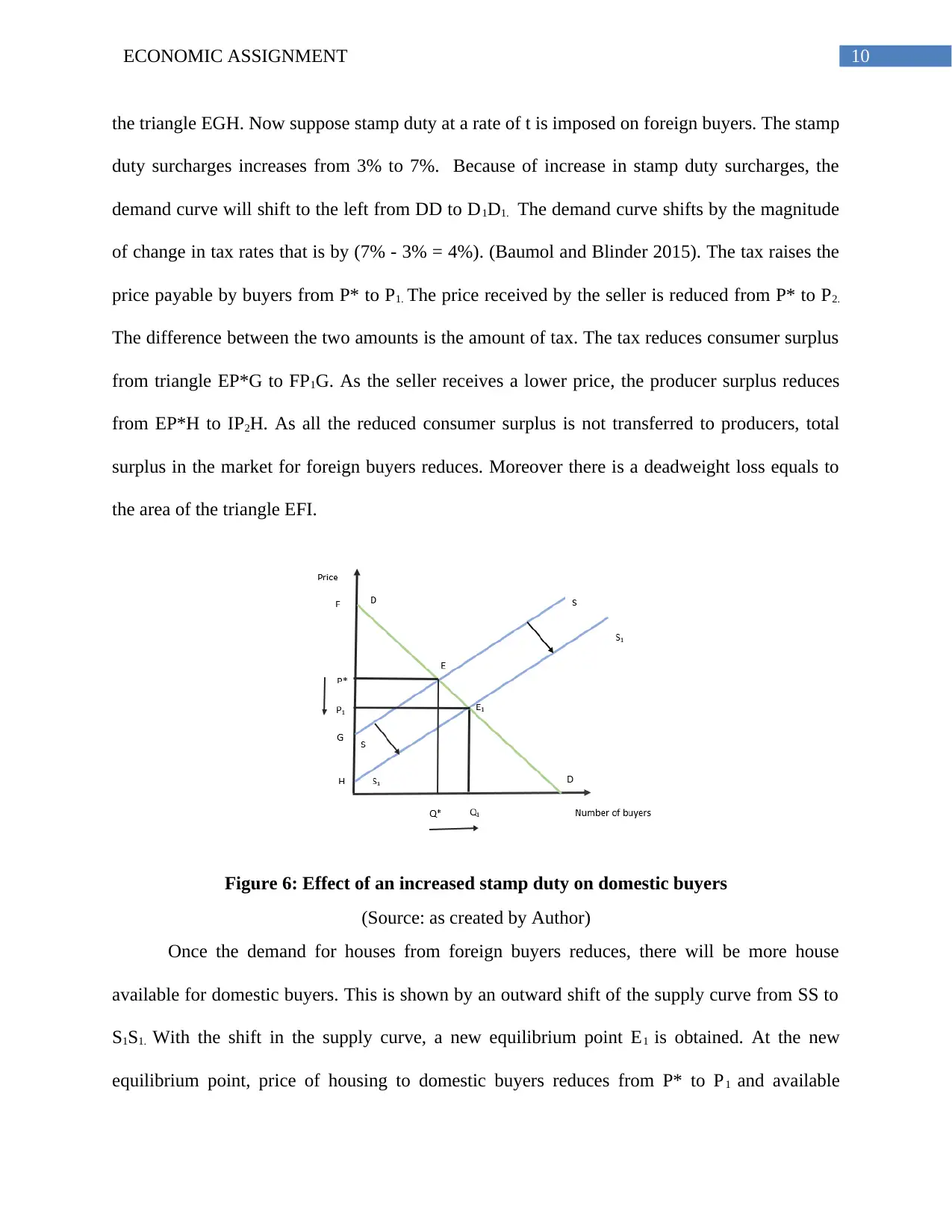
10ECONOMIC ASSIGNMENT
the triangle EGH. Now suppose stamp duty at a rate of t is imposed on foreign buyers. The stamp
duty surcharges increases from 3% to 7%. Because of increase in stamp duty surcharges, the
demand curve will shift to the left from DD to D1D1. The demand curve shifts by the magnitude
of change in tax rates that is by (7% - 3% = 4%). (Baumol and Blinder 2015). The tax raises the
price payable by buyers from P* to P1. The price received by the seller is reduced from P* to P2.
The difference between the two amounts is the amount of tax. The tax reduces consumer surplus
from triangle EP*G to FP1G. As the seller receives a lower price, the producer surplus reduces
from EP*H to IP2H. As all the reduced consumer surplus is not transferred to producers, total
surplus in the market for foreign buyers reduces. Moreover there is a deadweight loss equals to
the area of the triangle EFI.
Figure 6: Effect of an increased stamp duty on domestic buyers
(Source: as created by Author)
Once the demand for houses from foreign buyers reduces, there will be more house
available for domestic buyers. This is shown by an outward shift of the supply curve from SS to
S1S1. With the shift in the supply curve, a new equilibrium point E1 is obtained. At the new
equilibrium point, price of housing to domestic buyers reduces from P* to P1 and available
the triangle EGH. Now suppose stamp duty at a rate of t is imposed on foreign buyers. The stamp
duty surcharges increases from 3% to 7%. Because of increase in stamp duty surcharges, the
demand curve will shift to the left from DD to D1D1. The demand curve shifts by the magnitude
of change in tax rates that is by (7% - 3% = 4%). (Baumol and Blinder 2015). The tax raises the
price payable by buyers from P* to P1. The price received by the seller is reduced from P* to P2.
The difference between the two amounts is the amount of tax. The tax reduces consumer surplus
from triangle EP*G to FP1G. As the seller receives a lower price, the producer surplus reduces
from EP*H to IP2H. As all the reduced consumer surplus is not transferred to producers, total
surplus in the market for foreign buyers reduces. Moreover there is a deadweight loss equals to
the area of the triangle EFI.
Figure 6: Effect of an increased stamp duty on domestic buyers
(Source: as created by Author)
Once the demand for houses from foreign buyers reduces, there will be more house
available for domestic buyers. This is shown by an outward shift of the supply curve from SS to
S1S1. With the shift in the supply curve, a new equilibrium point E1 is obtained. At the new
equilibrium point, price of housing to domestic buyers reduces from P* to P1 and available
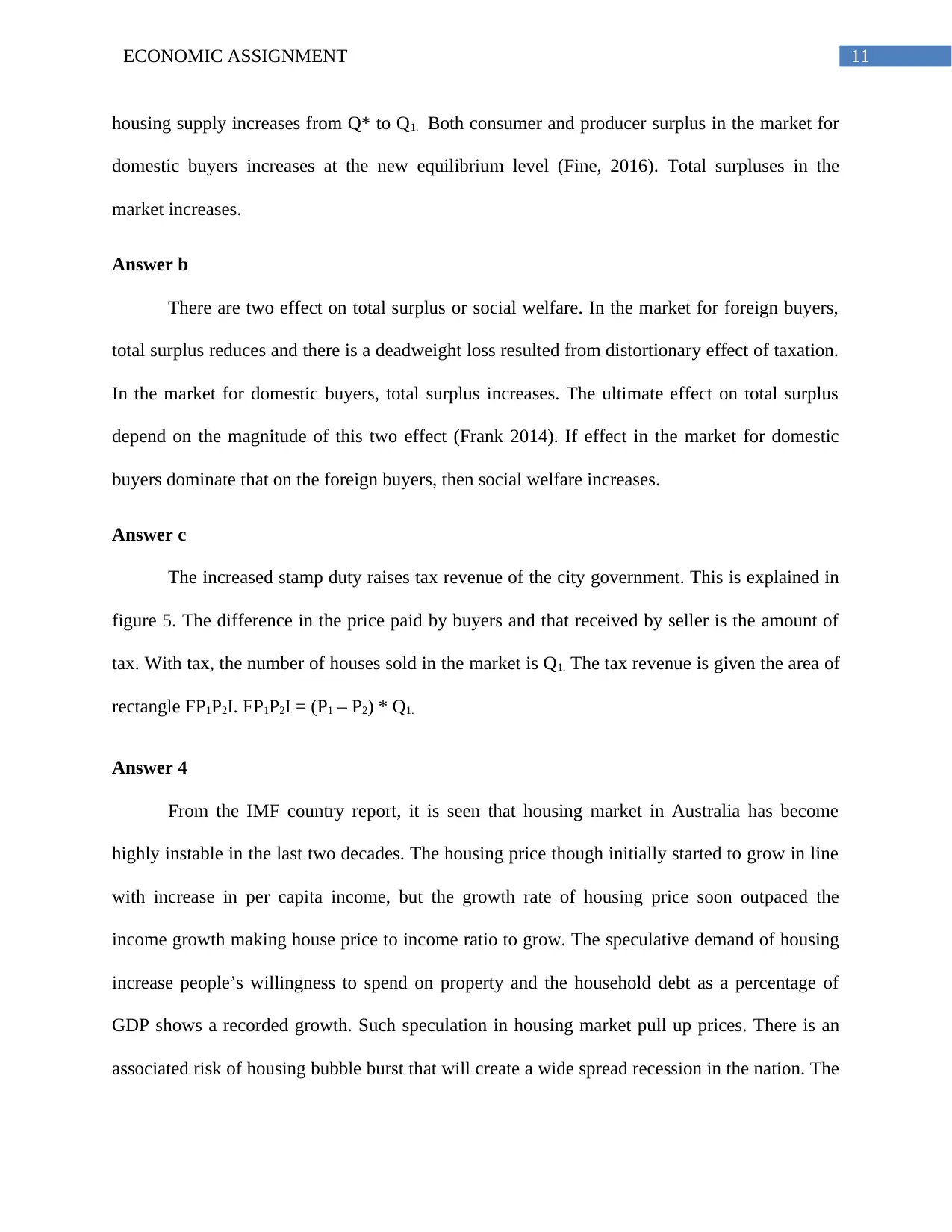
11ECONOMIC ASSIGNMENT
housing supply increases from Q* to Q1. Both consumer and producer surplus in the market for
domestic buyers increases at the new equilibrium level (Fine, 2016). Total surpluses in the
market increases.
Answer b
There are two effect on total surplus or social welfare. In the market for foreign buyers,
total surplus reduces and there is a deadweight loss resulted from distortionary effect of taxation.
In the market for domestic buyers, total surplus increases. The ultimate effect on total surplus
depend on the magnitude of this two effect (Frank 2014). If effect in the market for domestic
buyers dominate that on the foreign buyers, then social welfare increases.
Answer c
The increased stamp duty raises tax revenue of the city government. This is explained in
figure 5. The difference in the price paid by buyers and that received by seller is the amount of
tax. With tax, the number of houses sold in the market is Q1. The tax revenue is given the area of
rectangle FP1P2I. FP1P2I = (P1 – P2) * Q1.
Answer 4
From the IMF country report, it is seen that housing market in Australia has become
highly instable in the last two decades. The housing price though initially started to grow in line
with increase in per capita income, but the growth rate of housing price soon outpaced the
income growth making house price to income ratio to grow. The speculative demand of housing
increase people’s willingness to spend on property and the household debt as a percentage of
GDP shows a recorded growth. Such speculation in housing market pull up prices. There is an
associated risk of housing bubble burst that will create a wide spread recession in the nation. The
housing supply increases from Q* to Q1. Both consumer and producer surplus in the market for
domestic buyers increases at the new equilibrium level (Fine, 2016). Total surpluses in the
market increases.
Answer b
There are two effect on total surplus or social welfare. In the market for foreign buyers,
total surplus reduces and there is a deadweight loss resulted from distortionary effect of taxation.
In the market for domestic buyers, total surplus increases. The ultimate effect on total surplus
depend on the magnitude of this two effect (Frank 2014). If effect in the market for domestic
buyers dominate that on the foreign buyers, then social welfare increases.
Answer c
The increased stamp duty raises tax revenue of the city government. This is explained in
figure 5. The difference in the price paid by buyers and that received by seller is the amount of
tax. With tax, the number of houses sold in the market is Q1. The tax revenue is given the area of
rectangle FP1P2I. FP1P2I = (P1 – P2) * Q1.
Answer 4
From the IMF country report, it is seen that housing market in Australia has become
highly instable in the last two decades. The housing price though initially started to grow in line
with increase in per capita income, but the growth rate of housing price soon outpaced the
income growth making house price to income ratio to grow. The speculative demand of housing
increase people’s willingness to spend on property and the household debt as a percentage of
GDP shows a recorded growth. Such speculation in housing market pull up prices. There is an
associated risk of housing bubble burst that will create a wide spread recession in the nation. The
⊘ This is a preview!⊘
Do you want full access?
Subscribe today to unlock all pages.

Trusted by 1+ million students worldwide
1 out of 15
Related Documents
Your All-in-One AI-Powered Toolkit for Academic Success.
+13062052269
info@desklib.com
Available 24*7 on WhatsApp / Email
![[object Object]](/_next/static/media/star-bottom.7253800d.svg)
Unlock your academic potential
Copyright © 2020–2025 A2Z Services. All Rights Reserved. Developed and managed by ZUCOL.





